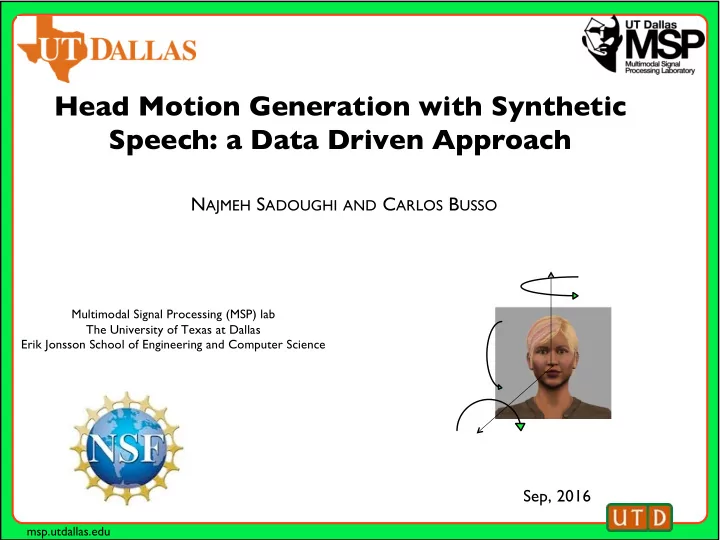

Head Motion Generation with Synthetic Speech: a Data Driven Approach N AJMEH S ADOUGHI AND C ARLOS B USSO Multimodal Signal Processing (MSP) lab The University of Texas at Dallas Erik Jonsson School of Engineering and Computer Science Sep, 2016 msp.utdallas.edu
Motivation • Head motion and speech prosodic patterns are strongly coupled • Believable conversational agents should capture this relationship • Speech intelligibility [K. G. Munhall et al., 2004] • Naturalness [C. Busso et al., 2007, C. Liu et al., 2012, Mariooryad et al., 2013] • Rule-based approaches • Rely on the content of the message to choose the movement • Synchronization with speech is challenging • Speech-driven approaches • Learn the coupling from synchronized motion [Sadoughi et al., 2014] capture and audio recordings 2 msp.utdallas.edu
Motivation Speech-driven F ramework Scaling Don’t you have anything on file here? Speech-driven F Text-to-speech ramework • Training with synchronized speech and head movement recording, testing with synthetic speech [Van Welbergen, Herwin et al., 2015] Testing Training t-1 t M Speech: i s m a t c h t-1 t Recorded Audio Speech: H h&s H h&s Synthesized H h&s H h&s Head Pose: Speech (TTS) Head Pose Head Pose Speech Speech Recorded Motion Speech Head Pose Speech Head Pose Capture • This paper addresses the problem with the mismatch 3 msp.utdallas.edu
Overview Original Synthesized Our Proposal Aligned Training or adaptation Testing t-1 t Speech: t-1 t Parallel corpus with Speech: synthetic speech H h&s H h&s Synthesized H h&s H h&s Speech (TTS) Head Pose: Speech Head Pose Speech Head Pose Recorded Motion Speech Head Pose Speech Head Pose Capture msp.utdallas.edu 4
Corpus: IEMOCAP • Video, audio and MoCap recording • Dyadic interactions • Script and improvisation scenarios • We used 270.16 mins (non- overlapping speech) • Three head angular rotations • F0 and intensity (Praat) • Mean normalization per subject • Variance normalization, globally 5 msp.utdallas.edu
Parallel Corpus • OpenMary: open source text-to-speech (TTS) Synthetic speech • Aligning the synthesized and original speech (word-level) [Lotfian and Busso, 2015] • Praat warps the speech (pitch synchronous overlap add) • Replacing the zero segments with silent recordings • Mean normalization per voice • Variance normalization to match the variance of the neutral segments in IEMOCAP Original speech Aligned synthetic speech 6 msp.utdallas.edu
Modeling t-1 t • The dynamic Bayesian network H h&s H h&s proposed by Mariooryad and Busso Speech Head Pose Speech Head Pose (2013) • Captures the coupling between speech prosodic features and head pose H h&s • Full observation during training Speech Head Pose • Partial observation during testing • Initialization by VQ 7 msp.utdallas.edu
Experiments • Three training settings: • C1 (Baseline): • Train with natural recordings H h&s − Mismatch Speech Head Pose • C2: • Train with the parallel corpus − Synthetic speech is emotionally neutral • C3: • Train with natural recording and adapt n n x µ + p pi i Adaptation µ = i to synthetic speech n n + p • Mean and covariance adaptation ( ) t t n ( ) n ( x x )( x x ) ∑ + µ − µ + − − p pi pi i i i i i ∑ = • Adaptation only on speech i n n + p 8 msp.utdallas.edu
Objective Evaluation • 5-fold cross validation • CCA s&h • CCA between the input speech and the generated head motion sequences • KLD • The amount of information lost by using the synthesized head movements distributions compared to the original one Turn-based CCA s&h KLD M1 0.8615 8.4617 Train & Test with original C1 0.8103 8.3530 * p < 0.05 Train with original C2 0.7901** 4.7579 Train with parallel corpus ** p < 0.01 C3-1 0.8399 ** 8.6299 Mean adaptation C3-2 0.8189 * 9.3203 Mean & Covariance adaptation msp.utdallas.edu 9
Subjective Evaluation AMT • Smartbody to render BVH files • 20 videos with the three conditions (C1, C2, C3-1) • 2 consecutive turns, to incorporate enough context • Each evaluator is given 10 x 3 videos • 30 evaluators in total • Each video is annotated by 15 raters • Kruskal-Wallis test (pairwise comparison) • C1 and C3-1 are different (p < 7.4e − 7) • C1 and C2 are different (p < 3.5e − 3) 10 msp.utdallas.edu
Subjective Evaluation Trained with Trained with aligned s Adapted to the aligned original speech ynthetic speech synthetic speech 11 msp.utdallas.edu
� � Conclusions • This paper proposed a novel approach to scale a speech-driven framework for head motion generation to synthetic speech • We proposed to use a corpus of synthetic speech with time- aligned signals to the natural recordings • We used the parallel corpus to retrain or adapt the model to the synthetic speech (C2, and C3) • This approach reduces the mismatch between train and test • Both objective and subjective evaluations demonstrate its benefits � msp.utdallas.edu 12
Future Work • Adding emotional behaviors into our models • Including other facial gestures (e.g., eyebrow motion) and hand gestures • Constraining the generated behaviors on the underlying discourse function of the message to generate meaningful behaviors � msp.utdallas.edu 13
Multimodal Signal Processing (MSP) • Questions? http://msp.utdallas.edu/ ! msp.utdallas.edu 14
Recommend
More recommend